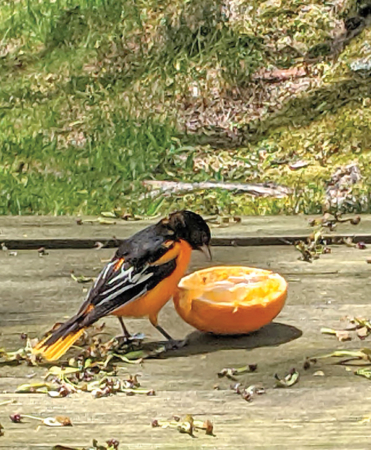I’m not talking baseball here, but rather my topic this week is actually about those eye-catching birds that occasionally grace our backyards this time of year. To be fair, I’ll admit I’m not a hardcore, dedicated bird watcher, but I do enjoy having a variety of birds around my home, and like a lot of other folks, I have bird feeders out to attract the many different species. One species that seems to spark a lot of attention is the Baltimore Oriole, now often referred to as the Northern Oriole. Several years back, my wife and I were fortunate to have some show up briefly but then nothing for several years after that. This year our daughter-in-law, who lives only a half-mile from us, has been able to attract a fair number of the orioles to her backyard, thus setting off a bit of a competition. We have gone into “full attack mode” to attract more Baltimore Orioles; Angie still leads, but we finally have a couple showing up regularly.
All of this attention to the Baltimore Orioles lately has caused me to delve more into the subject, so here is a bit of what I have found. The male oriole will display a bright orange to a yellow-orange breast and neck with black showing up elsewhere; also, there will be white bars through the wings. The female will display an orange-yellow breast and a yellowish-brown on the upper parts with somewhat darker wings. Be careful not to confuse the Rufous-sided Towhee with the oriole; the Towhee is a duller orange-brown on the breast, and it lacks light bars through the wings. Also, the Towhee will be more often seen scratching in the leaves on the ground.
While the Baltimore Oriole is still quite common, there may have been some decline, probably partly due to the loss of our elms trees, which were a favorite nesting site for orioles. Baltimore Orioles prefer open woods over deeply wooded areas and can often be found in orchards and parks in towns. Baltimore Orioles are found throughout northeastern and central United States and even into Canada. The orioles’ winter in the tropics often starting their fall migration as early as July or August.
Their nests are quite unique; it’s a bag-shaped hanging nest made of woven plant fibers, grapevine, grass, and even yarn or string and lined with plant down and hair if available. The nests hang from the end of a tree branch, usually higher up in a tree.
This is probably no secret to bird watchers, but if you want to attract some of these colorful birds to your backyard, put some sliced oranges out back and keep your eyes open. Actually, Baltimore Orioles like fruit, and they have been known to go to hummingbird feeders as well. Orange seems to be a color that attracts them-probably because people put sweet tasting oranges out for them. These orioles also feed on insects like beetles, wasps, spiders, grasshoppers, and especially caterpillars. They will also eat various kinds of berries.
Now you may want to go buy a bag of oranges and get your own neighborhood competition going.





Leave a Comment
Your email address will not be published. Required fields are marked with *